Island of bounties
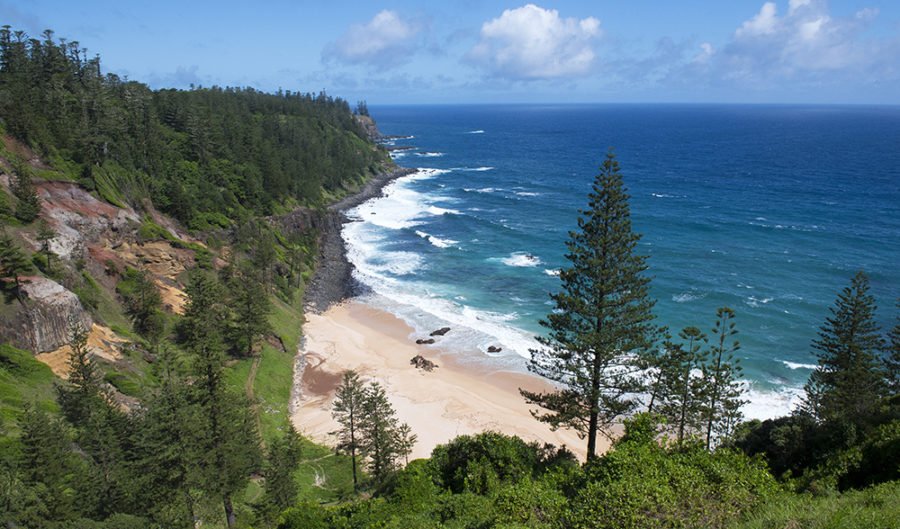
THICK CLOUD PREVENTS me from seeing Norfolk Island until moments before my plane touches down, when green hills and the deeper green of thousands of tall pines are revealed.
As we taxi down the runway, quickly covering a significant chunk of Norfolk’s 3500ha, we are greeted by waving locals – it’s a warm welcome that introduces me to the island’s friendly character and laid-back charm. The excitement distracts me from the fire station at the end of the runway, where fire crews display signs rating each pilot’s landing on a scale of 1 to 10, adding cheeky comments for pilots they know personally.
Despite having a lifelong fascination with remote islands, and having passed very close to Norfolk during my 2011 solo around-the-world sailing voyage, it is only on arrival that I realise how little I know about this small Australian territory. Located in the Pacific Ocean, 1470km east of Brisbane, Norfolk is home to one of Australia’s most geographically isolated communities.

Incoming pilots are given a rating for their landings by the watching fire crew who display their score and the occasional comment on the station window at the end of the runway. (Image: Don Fuchs)
Surrounded in every direction by hundreds of kilometres of sea, it seems a world in itself, and is often referred to as ‘the rock’ – a description that seems appropriate for an island encircled by steep rocky cliffs that are broken only occasionally by stony beaches and stretches of golden sand.
Like its ‘neighbour’ Lord Howe Island, 900km to the south-west, Norfolk is the eroded remnant of a volcano that was active some 2–3 million years ago. The landscape, predominately made up of rolling plains and dense pine forests, is dominated by Mt Bates, which, at 321m, is the highest point of the submerged Norfolk Ridge.
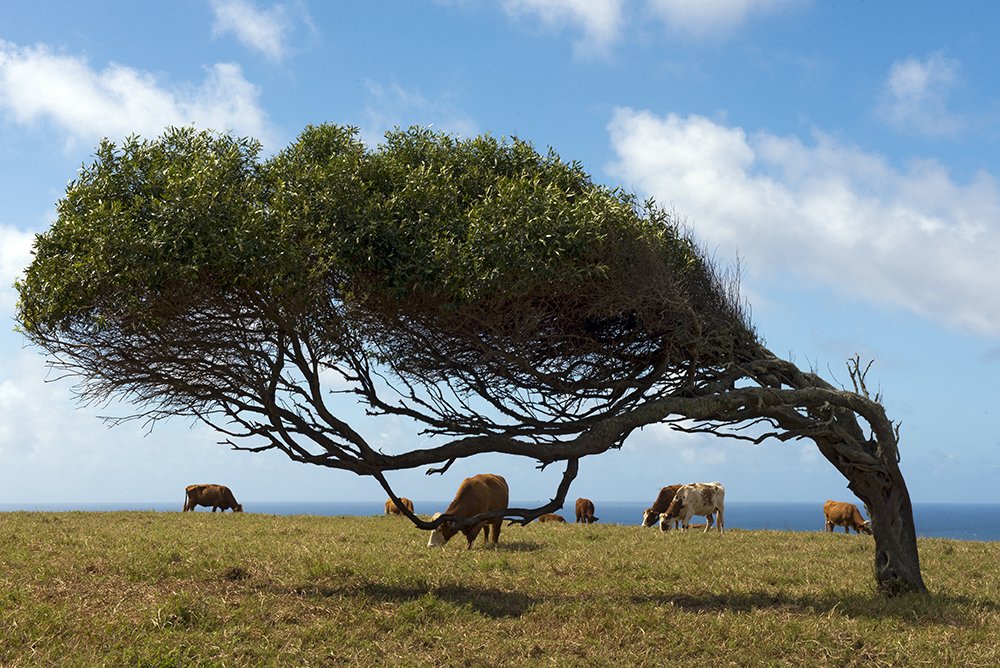
Strong winds have left their mark on a tree on Point Howe on the island’s northern tip. (Image: Don Fuchs)
UNFORTUNATELY, I FIND THAT Mother Nature isn’t as welcoming as the locals. During my first evening on Norfolk, the skies open up and release a South Pacific deluge that makes sunshine seem very far away. I’m left wondering whether my five-day stay will be a soggy one.
But the next morning, I am pleasantly surprised; the rain has slowed and low, heavy clouds hang in the sky, producing a grey, moody light that instils the landscape with a sense of mystery. I am eager to explore the island, and so I drive out of Norfolk’s main settlement, the township of Burnt Pine, and head to a somewhat unconventional first stop: the graveyard.
Perched on a grassy plain overlooking a sandy beach, the graveyard features recently laid headstones alongside those dating back to the original 1788 English settlement. Salt spray fills the air as the turbulent ocean crashes onto the sand, and rain falls in misty sheets. As I examine the older gravestones, I am intrigued by the island’s history. I notice the early inhabitants were lucky if they lived beyond their 30th birthday and I can’t help but think how different their lives must have been to mine; I am in my early 20s and envisage many adventures to come.
Norfolk’s history is well documented, which is understandable, given that the small island’s story is a colourful one. Inhabited first by Polynesian voyagers, who lived here between the 11th and 15th centuries, Norfolk was later added to the long list of places documented by Captain Cook. He sighted it in 1774, during his second voyage to the South Pacific aboard HMS Resolution. He named the island after Mary Howard, Duchess of Norfolk.
Believing that the island’s pines might make good masts and that the local flax could be used for ships’ sails and rigging, governor Phillip ordered that HMS Supply – the armed tender of the First Fleet – set sail for Norfolk and establish a settlement, only days after landing in Botany Bay in 1788. Some settlers – a mix of convicts and free men and women who were dependent on outside provisions provided by the flagship of the First Fleet, HMS Sirius – later packed up and left. Sirius remained, wrecked on one of the island’s treacherous reefs. Today, the ship provides what Janelle Blucher, acting director of the Norfolk Island Museum, describes as “possibly the most significant array of First Fleet cultural material anywhere in the world”.

Convict-era military barracks overlook the New Gaol ruins. Beyond the buildings historic Kingston Pier stretches into Slaughter Bay. (Image: Don Fuchs)
The island remained empty for 11 years before a second British settlement, a penal colony, was established in 1825. The convicts were subjected to brutal treatment and the island quickly earned a reputation for being hellish. This changed with the arrival of inhabitants who weren’t banished to the island. These willing castaways were the Pitcairn Islanders, descendants of Fletcher Christian and his crew, infamous mutineers on HMS Bounty and Polynesian women.
Like many others on the island, Janelle is a descendant of the Bounty mutineers. “I have a direct, personal link to the Bounty/Pitcairn/Norfolk story, but I really connect with the other stories emotionally,” she tells me as we stand in the HMS Sirius museum, her small frame dwarfed by one of the anchors that was recovered from the wreck site. Janelle considers her role in the museum as one of the best jobs on the island and she relishes being among the stories and relics that are part of Norfolk’s history. “There are so many interconnections to all the different layers of history as well as the characters that were involved,” she says.
Despite the island’s interesting past, residents are also focused on the future. The island is the only non-mainland Australian territory to have gained self-governance, granted in 1979.
However, a new chapter in Norfolk’s story is being written. In May 2015 the Norfolk Island Legislation Amendment Act 2015 was passed; it stipulated that, from 2016, the Australian government would resume control of Norfolk. Many residents are opposed to the change, which took effect on 1 July last year. A group of locals is petitioning the UN to help obtain the right to self- determination and it’s nearly impossible to hold a conversation on the island without the current upheaval being raised.

After navigating some of the world’s most challenging oceans and surviving seven knockdowns in her small sailboat, then 16-year-old Jessica Watson became the youngest person to sail solo, non-stop and unassisted around the world in 2010. (Image: Don Fuchs)
NORFOLK’S HISTORY IS NOT ONLY SHOWCASED in museums; it’s also etched into the landscape. Most of the island’s native vegetation was cleared during the early days of the European settlements, but the 655ha protected area encompassing Norfolk Island National Park and Norfolk Island Botanic Garden gives visitors a taste of what the area would once have been like. The national park, which encircles Mt Bates in the island’s north, is made up of subtropical rainforests, and dotted with palm forests and stands of towering pines. Bordered by impressive cliffs offering views over dramatic seascapes, the forests are filled with endemic species, including the Phillip Island hibiscus, which was once thought to be extinct, and the imposing Norfolk tree fern, one of the world’s largest tree ferns.
Norfolk is also home to an array of native birds and insects. As we stand under the thick rainforest canopy, park manager Craig Doolan tells me that of the island’s four endemic bird species, the Norfolk green parrot is of particular note, because it is one of the world’s rarest parrots (along with Australia’s night parrot and New Zealand’s kakapo). “In 2012 there was a census that said there could be as few as 46 birds left,” says Craig, who is a devoted campaigner for the species.
Craig and his team have established a dedicated breeding program to help safeguard the species and they are working to predator-proof a number of nesting sites. Craig proudly shows me one of the protected nests in a nearby tree, explaining that “the predator-proofing allows [the birds] to rest in peace without getting harassed by cats and rats”. Today, Craig estimates there are between 160 and 200 green parrots on the island. “Last year we had 80 chicks, and considering three years ago we had an entire population of less than that, it makes a really big difference,” he says.
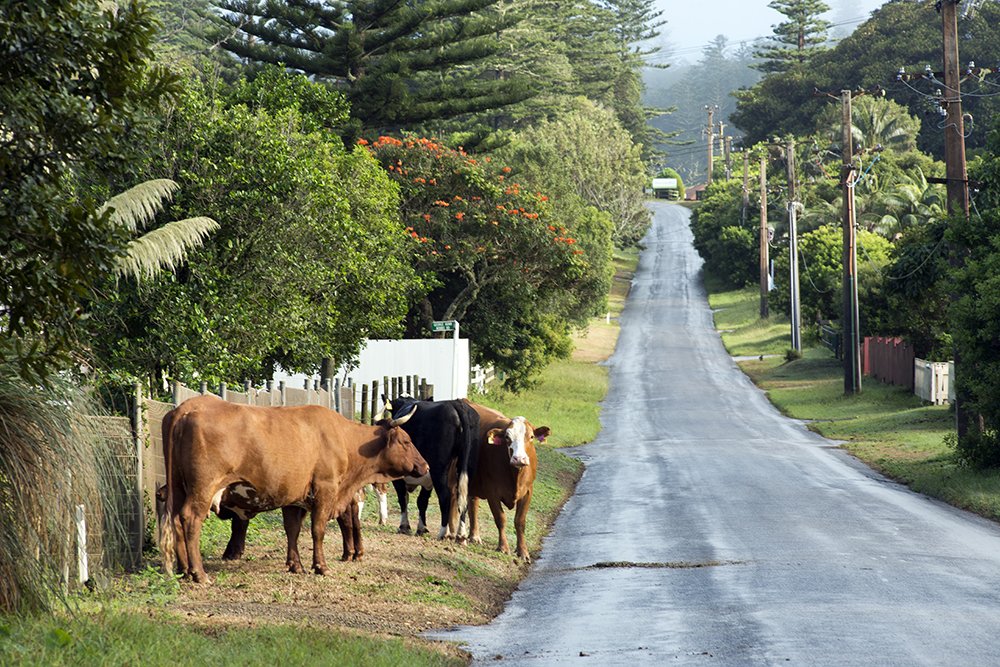
Cows are free to roam on public land and have right of way on the roads. (Image: Don Fuchs)
BEYOND THE NATIONAL PARK, much of Norfolk is grazing land for cattle, or farmland. Fruit and vegetables are prohibited imports, so fresh produce is grown locally. The landscape, which features pastures, orchards, and farm plots, is also peppered with Indian banyan trees. The huge maze of roots and branches that extend from these striking figs creates fantastic playgrounds for the island’s kids, who generally enjoy an incredible amount of freedom.
For many young people, however, this sense of freedom disappears with adolescence, as it begins to dawn on them how remote their home is. Shay Wilson, a final-year student at the local high school, was born on the island. She says “it’s really cool” to be surrounded by water, but also describes the thousands of kilometres of ocean separating Norfolk from the mainland as “isolating”.
This isolation is emphasised by the island’s lack of a safe harbour. Without a place for supply ships to safely dock, Norfolk relies on a time-honoured but precarious and finely honed procedure known as ‘lighterage’ to receive cargo. Every few weeks, the process sees cargo transferred from supply ships to wooden boats known as ‘lighters’. These are towed ashore by motor launches, and the cargo is winched onto one of the island’s two sturdy piers. If locals hadn’t shown me images of livestock, cars, and even trucks delicately perched on the lighters, and being manoeuvred through the surging swells, I wouldn’t have believed the process was possible.
John Christian Bailey, a direct descendant of Bounty mutineer leader Fletcher Christian, is the man responsible for Norfolk’s boat building. In his large workshop, filled with the aromas of wood and epoxy, and the clamour of boat builders at work, the quietly spoken shipwright shows me his latest creation; propped up in the final stages of construction is a lighter known simply as No. 3.
“An old Dutchman, Peter Swynenburg, used to build them years ago,” John explains. “He built them up to number 12, which is still in service today…then he retired and they got me to start building from then on. We didn’t want to name a boat 13 so we started back at 1.” Built from local spotted gum and Norfolk pine, the lighters are similar in appearance to old whaling skiffs. “They’ve sorta got wider, longer and higher as the years go by to suit our cargo needs,” says John. One of the benefits of the traditional wooden construction is that the boats’ sides will flex on impact as they bump against supply ships in the turbulent waters.
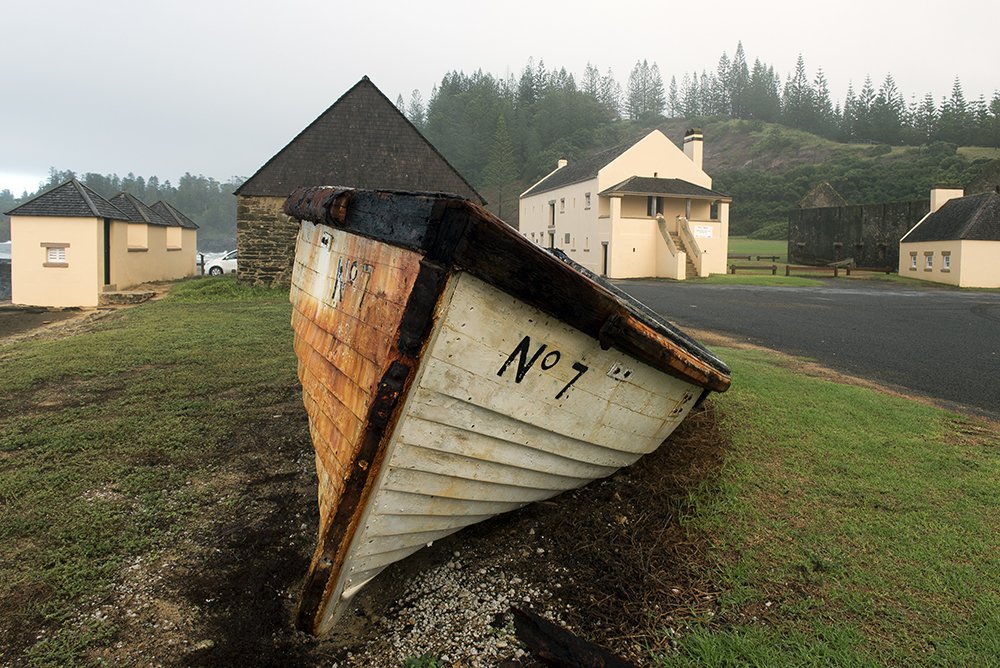
A traditional lighter, once used to bring supplies ashore, lays on the historic Kingston waterfront. (Image: Don Fuchs)
THE LIGHTER TRADITION IS JUST ONE of the many elements that make Norfolk so charming. There’s also its history, its friendly locals, and its unique topography and isolation. Alone, these things are not exceptional, but together they capture the essence of Norfolk and make the island a remarkable place.
As I wander around World Heritage-listed Kingston, in the island’s south, I am struck by the old-world charm of the historic buildings and ruins that sit perched on a grassy plain overlooking Emily and Slaughter bays. During the evenings, local families make use of nearby barbecues and picnic tables, and the convict-era buildings are lit up, bringing the island’s ghosts to life.
Rimmed by sea cliffs and assailed by the unruly ocean, Norfolk’s natural environment is just as striking. I won’t forget the sheer magnificence of afternoon light illuminating sea spray between cliff-edge pines, or the views of ocean and empty horizon that visitors can enjoy from park benches dotted along the coastline. Stopping for a moment on one of these, I hear the roar of wind through the pines, and the distant sound of ocean crashing against cliffs, mingled with clucking from the island’s many feral chooks.
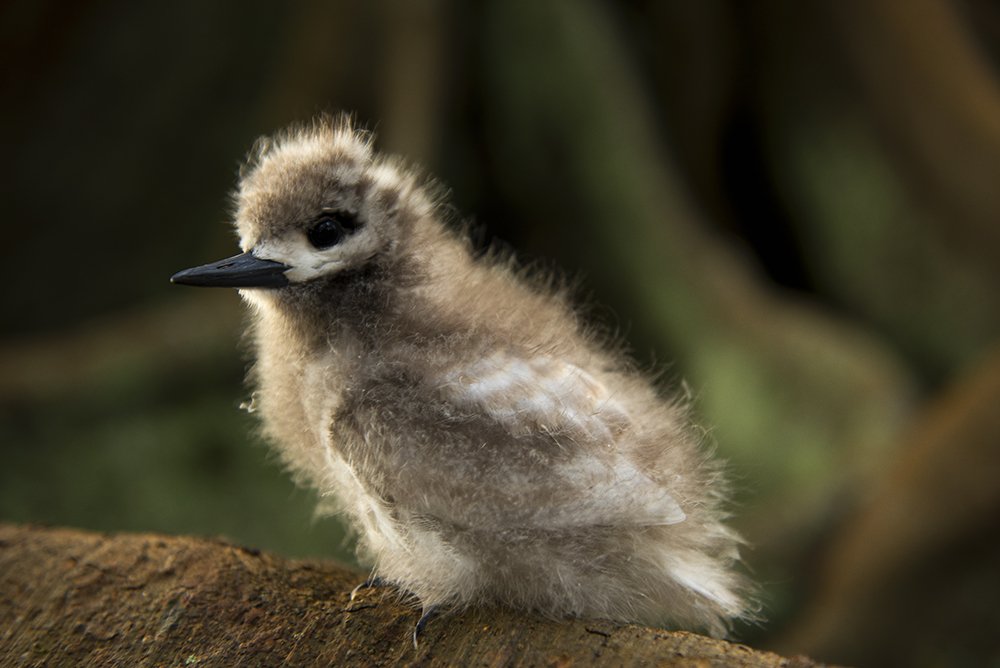
White terns lay their eggs on the branches of pine trees. Their fluffy chicks will remain there until they’re ready to fly. (Image: Don Fuchs)
More than anything, it’s the local characters that give Norfolk its true charm. The island is home to a bustling community that has developed an idiosyncratic system of ‘hunting and gathering’, as local guide Rick Kleiner describes it. Residents don’t buy fresh produce from shops; instead, just about everyone has a vegie garden and those who have excess or specialty produce leave it in an honesty box at the front of their property.
The tight-knit nature of the local community is reflected in a special section of the phonebook that lists residents by their nicknames. But although the numbers for ‘Baldie’, ‘Loppy’, ‘Spud’, and ‘Wiggy’ are easy to find, I doubt many people open the phonebooks, because, in my experience, contacting ‘Foxy’, ‘Goldie’, or ‘Goof’ is as simple as asking the nearest person where they might be.
After five days on the island, I feel I’ve been accepted into Norfolk’s fold. As I drive along the main street of Burnt Pine, I find it’s best to keep one hand raised from the steering wheel since every driver that passes greets me with a friendly wave. Their welcoming spirit seemingly extends beyond visitors, to the island’s livestock.
Emily Ryves, a cheerful goat farmer who has lived on Norfolk for the better part of her life, treats her goats to ‘tea’ (warm water and molasses) after she milks them, and, on roads all over the island, priority is given to the free-roaming cows that frequent the public land and nature strips. Apparently, gravestones have been moved to accommodate the grazing preferences of these four-legged locals.
As I head towards the airport, past pine-studded hills dotted with cattle, I am greeted with one last reminder of the island’s quirky charm; a member of the local fire crew is heading to the station with a surfboard strapped to the top of the emergency vehicle. I wonder how the crew will score today’s landing.
Essentials
Getting there
Air New Zealand offers flights from Sydney on Mondays, Fridays and Sundays, and from Brisbane on Tuesdays and Saturdays. Australian residents are required to take photo identification, preferably passports.
Climate
Norfolk enjoys a pleasant subtropical climate. Average summer temperatures range from 18°C to 25°C and average winter temperatures range from 13°C to 19°C. Most rainfall occurs during the colder months, from May to August, and the humidity remains relatively high year-round.
Where to stay
There are plenty of accommodation options, including small hotels, self-contained units, cottages, and holiday houses. Visitors can choose between ocean views or the convenience of a central location at Burnt Pine. For more information, visit www.norfolkisland.com.au/accommodation.

